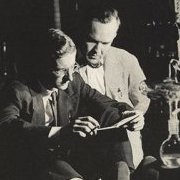-
Posts
4586 -
Joined
-
Last visited
-
Days Won
12
Content Type
Profiles
Forums
Events
Everything posted by hypervalent_iodine
-
Alternatively, you can just make up your silica 'slurry' with your solvent + 5% TEA and run the column with 1%, which would seem less wasteful than using straight TEA. It works for the benzyl amines I use, at any rate. As I mentioned before, gka, you will need to pretreat your plates with your solvent + TEA. If you haven't done this, it may explain why you aren't seeing any movement on your plates. Run your plate in the solvent before you spot your stuff onto them, let it dry and then run them with your compound spotted onto it. Additionally, if you are using KMnO4 or Goofy dip to develop your plates, you might be finding your plate difficult to visualise. Vanillin stain has always worked well for me, so you might want to give that a try as well (if you haven't already).
-

Question about Markovnikov Addition
hypervalent_iodine replied to tony montana's topic in Organic Chemistry
Hydrogen only acts as a nucleophile when it is a hydride. In the form of HBr, H is not a nucleophile. It might be easier for me to help you if you could put the question on here, is that possible? -
Amines are typically quite sticky and hard to purify via silica chromatography. MeOH/DCM with TEA is what I would have recommended, but you seem to have tried that already! Can I ask what you're using to develop your plates and are you pre-treating your plates with your solvent? Depending on what else is in the crude, you might be able to purify it using a simple acid base work up. Do you have any idea of what else is in there?
-

Question about Markovnikov Addition
hypervalent_iodine replied to tony montana's topic in Organic Chemistry
Can you tell me why they are confusing you? -
Edit: The thread seems to have fixed itself, so I suppose my confusion has been remedied.
-
I do 100% agree with your safety concerns. As mississippi said, we have had some very dodgy characters come through here who have been refused help on the basis of their questions. In relation to this topic however, I think that the process of obtaining the Mg0 from the salts is arduous and expensive task and honestly not worth the effort in the long run for a backyard chemist. I'm not trying to pick an argument with you, I just think that sometimes it is okay to give the benefit of the doubt and ask more questions before you decide whether or not to help someone. Additionally, you'll notice that I haven't yet given any helpful information to the OP as yet. I'm not completely reckless in the advise I give and I do request that adequate information be given before I even consider giving my opinion as a chemist in all the replies that I author. To the OP: To save needless debate like this in the future, could you please refer to the following thread and heed its advise regarding point 2.) http://www.sciencefo...cit-substances/ Another thing to note with these types of fires is that the types of extinguishers you are meant to use for them (D class in Australia, I'm not sure what the classification system is elsewhere) only suffocate the fire. If you disturb the powder, the heat still present will cause it to reignite once exposed. Certainly not a type of fire I would ever want to deal with in a lab (that being said, I wouldn't want to deal with most any fires in a lab).
-
I agree that magnesium is in plants, but it isn't in the form of elemental magnesium. If this person were to extract it, all they'd be doing is extracting magnesium salts or some other type of coordination complex. I think it's a little farfetched to assume that this person is then going on to turn this into metal to create explosives. I mean really, why go to the effort when there are other far more commonly used, very easily obtained and much better working substances out there? And as you yourself pointed out, it would be much easier to extract from sea water. It seems more likely that this would be a homework question given that an answer was required 'immediately'. Obscure or not, I don't see any reason why it wouldn't be.
-
I wouldn't think june022 is looking to extract elemental magnesium, since I seriously doubt there are plants that would contain it. June022, specifically what are you trying to extract? Magnesium salts?
-
I second this comment. As for your second question, a simple Google search should give you the answer. I presume this is homework?
-
I found this review in a quick search I did this morning, http://www.mendeley.com/research/evaluation-of-extraction-methods-for-recovery-of-fatty-acids-from-lipidproducing-microheterotrophs/. Unfortunately I didn't have time to read it, but the abstract suggested that volume of solvent doesn't have an affect on the extraction yield. Hope that's of assistance!
-

Me-CBS- A selective reduction reagent
hypervalent_iodine replied to apis's topic in Organic Chemistry
What do you need to know about it? -
Because flame tests are unreliable and you can make quantitative measurements with spectrometry and spectroscopy that you can't with with a flame test.
-
2 L.
-
Your definitions are a little off. Firstly, this isn't specifically reductions, it applies to any reaction. The thermodynamic product of a reaction is the product that is the most stable. For instance, if I wanted to add something across a double bond, the thermodynamic product would be the one where the thing I'm adding adds to the most substituted end. The kinetic product is simply the one that forms the fastest. So in my simplistic analogy above, the kinetic product would be where the substituent adds to the least hindered and therefore least substituted end. You can control which you get as a major product by lowering the temperature (for the kinetic product) or raising it (for the thermodynamic product).
-

Hydrazine Sulfate from Ketazine process
hypervalent_iodine replied to ercdndrs's topic in Organic Chemistry
Okay then, well then yes, it looks to me like it should be okay, but definitely practice safety. Most any aliphatic ketones should be fine with this reaction and the calcium hypochorite over the corresponding sodium salt will just mean that you produce CaCl2 instead of NaCl. The major difference will of course be in your stoicheometry. -

Hydrazine Sulfate from Ketazine process
hypervalent_iodine replied to ercdndrs's topic in Organic Chemistry
Would you perhaps be able to say what you want with hydrazine sulfate? The reaction you've listed is not a very nice reaction to do if you don't have experience or access to a fume hood. -
You should do your PhD on it an get back to us in a few years
-
I actually thought that something in the lemon juice might be binding in preference to the TRPV1 myself, but I couldn't find anything on it. So my best guess is that the citric acid is hydrolysing the amide. Presumably, cleaving it in half reduces its potency, or perhaps the amide is needed for efficient binding, etc. I did also just find this, from wiki
-
After eating a whole jalapeno, I found the only thing that actually worked to a significant degree and for more than 1 second was bananas. I ate about 5 of them over the course of half an hour. As for lemon juice, I am not entirely sure on the mechanism. I read a few things saying that it neutralised the alkaline nature of capsaicin, which I think is more or less true. Looking at the structure of capsaicin, I would guess that the citric acid could hydrolyse the amide present in its structure to give the corresponding benzyl amine and carboxylic acid, which would then take away the associated burn. But that's little more than a guess.
-
It is of course possible, but you find yourself needing to study a lot of basics first. But hey, if you have the motivation, by all means go for it. I would recommend you start by studying from a general chemistry text book first (Blackman's, "Chemistry" is the book used here) and work your way up. You may, however, find it more useful to build up your foundation knowledge with AP chem, as A Tripolation suggested.
-
You should be fine and I would not expect it to react to any extent with the azide. The easiest way to find out is of course to do a small scale reaction and figure out what you have at the end. Alternatively, you could do a reaction search with scifinder and see what other people use with similar reactions (though that's something you should have already done). If I'm not mistaken, this is another thread of yours: http://www.chemicalf...p?topic=49569.0 In response to this comment: Go look at your NMR and/or go and get a low res mass spec. I don't trust some LC-MS's as far as I can throw them, depending on who else is using (read: breaking) the machine. Additionally, without knowing the structure of your compound and the reaction conditions you are using to couple your amino acids and strip the finished peptide from the resin, it is impossible for anyone here or on chemical forums to give an opinion on what might have happened.
-
Uh huh. Well the point of your thread has been addressed, in any case. No, we can't tell you how to make it; no, I doubt you can buy at; and no, no one will make it for you. Be sure to come back to us when you have your anti-gravity device. $10 if you can produce a perpetual motion machine as well.
-
And furthermore, why do you think we're going to tell you how to synthesise this when you are ignorant on the topic of chemistry? Having looked at the synthesis, it involves a delightful array of rather high temperatures, pressures and toxic compounds. It's not even something I would trust myself doing without supervision, let alone someone with no experience or background in chemistry.

